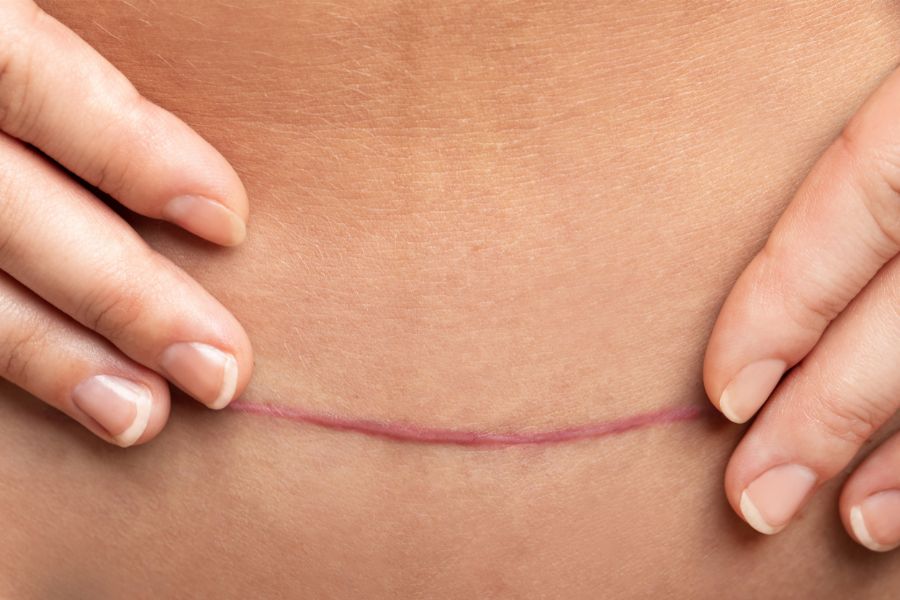The birth of a child is among the happiest moments we can experience – and bringing a new life into the world is one of the most profound things we can ever do – but at the same time, those first few weeks looking after a newborn baby can be extremely challenging.
This is even more the case if the baby was delivered by C-section because not only do you have to take care of your new child in your weakened state, but you also need to make sure you are getting the rest you need to let your body heal from major surgery.

As a result, making sure you get enough sleep is of the utmost importance – so in this post, we have all the information need about how to sleep after a C-section – as well as which positions to avoid.
How to sleep after a C-section
After a C-section, it can be difficult to find a sleeping position that doesn’t place any strain on your incision but that is still comfortable enough to allow you to sleep.
You will probably have to experiment a little until you find the right solution for you – but here are the four recommended positions you can try.
1. Back Sleeping
One of the best positions for sleeping after a C-Section is on your back, and this is the position many women find most comfortable.
The advantage is that sleeping in this position doesn’t place any pressure on your hips, knees or lower back.
At the same time, this is the position that places the least amount of strain on your incision, so it reduces the amount of discomfort you may feel from that area while also helping the incision to heal.
Furthermore, many people sleep in this position anyway, so it is one of the most natural sleeping positions you can adopt post-surgery.
If you need to raise your knees while sleeping in this position, you can also sleep with a pillow under your knees to support them. This is a recommended sleeping position after many types of surgery, including C-section.
The only issue with sleeping on your back after a C-section comes when moving to a sitting position – you shouldn’t just sit up directly but rather should roll over and push yourself up with your hands to avoid placing any strain on your incision.
2. Inclined Back Sleeping
Another option if you don’t like sleeping on your back is to try sleeping on your back at an inclined angle of around 45 degrees.
This may have been the position you slept in while you were still in the hospital, but hospital beds are adjustable to make this possible.
However, unless you have the same kind of adjustable bed at home, you will have to use pillows to prop yourself up in this position, and you may even need to buy some extra pillows if you don’t already have enough at home.
This position may feel more unnatural at first, but many women quickly become accustomed to sleeping like this, and it can provide relief from any discomfort from your incision because it helps relieve pressure on that area.
One of the main advantages of sleeping in this position is that it also helps reduce the risk of sleep apnea, a condition that causes the sleeper to stop breathing for a few moments as they sleep.
Sleep apnea is relatively common in women who have recently given birth, but it’s especially prevalent in those who delivered by C-section – and inclined back sleeping can lower the risk.
3. Side Sleeping
For women who don’t usually sleep on their back, it can sometimes be hard to adjust to this new sleeping position after giving birth – so sleeping on your side is also an option.
Like sleeping on your back, this position also minimizes the amount of strain that’s placed on your incision – although you may need to be careful when moving about.
If you want to sleep on your side, the best thing to do is to place pillows around your hips and stomach to give you some extra support as well as to prevent you from moving around too much while you sleep.
Other than this being a comfortable and natural sleeping position for many people, sleeping on your side also has the added advantage of making it easier to sit up or get out of bed since you can just push yourself up with your hands.
4. Sitting Up
Another option to try is sleeping in a sitting position, again, something you may already have experienced in hospital after your delivery.
Most people will find this position a little unnatural, but it still has its advantages.
Sleeping sitting up will mean you have to spend less time moving around trying to find a comfortable sleeping position and risking putting extra strain on your incision as you do it.
If you are breastfeeding, it will also be easier to feed your baby because you will already be in the correct position and won’t have to worry about pushing yourself up to do it, again, putting strain on your incision as you move.
However, even if you find sleeping in a sitting position convenient at first, it probably won’t be the best long-term solution, and you’ll probably revert to one of the other sleeping positions after a few days – or one or two weeks at most.
It’s also best not to remain in a single position for too long or you may end up developing bedsores.
If you decide upright sleeping is the best choice for you, as with inclined sleeping, you will probably need some extra pillows to make yourself comfortable and to make sure you don’t slide down once you are asleep.
Avoid Sleeping on Your Stomach After a C-Section
You can experiment with sleeping on your back, on your side or sitting up, but the one position you shouldn’t sleep in after a C-section is lying on your front.
This is because sleeping on your front can irritate your incision, causing it to heal more slowly – and you also risk dislodging your stitches before they are ready to be removed.
Don’t Treat Sleep as An Afterthought
If you are going to deliver your baby by planned C-section, you can prepare your sleeping arrangements in advance, but if you had an unplanned or emergency C-section, you may not have thought too much about how you were going to sleep after delivering your baby.
However, sleep is vitally important to new mothers – and for those who delivered by C-section especially – because not only do you have to make sure you have the energy to look after your new baby, but you also need to get enough rest to allow your body to heal.
This means you shouldn’t treat sleep as an afterthought – instead, you should take active steps to ensure that you are able to get the sleep your body needs.
Getting enough sleep with a new baby sleeping next to you may be far easier said than done – as all new mothers will confirm – but there are still plenty of things you can do to make things easier for yourself. So let’s have a look at some suggestions now.
Tips for Getting Good Sleep After a C-section
Add Extra Pillows to Your Bed
When you first return home and are trying to work out the best way to sleep, it will help if you have some extra pillows on your bed that you can arrange to make yourself as comfortable as possible.
This means you should bring extra pillows in from other rooms if you have them – or if not, you might consider sending somebody out to buy some more for you.
Prop Your Head up If Sleeping on Your Back to Prevent Sleep Apnea
If you sleep on your back, try to prop your head up a little to reduce the risk of sleep apnea. However, if you still suffer from sleep apnea, it might be better to sleep at a 45-degree angle or even sitting up.
Make Sure Everything You Need Is Within Reach
When you return home after giving birth, prepare your sleep area – or rather, ask someone to help you prepare it – to make sure that everything you need is within easy reach.
This will ensure you don’t need to get out of bed and move around more than necessary and that you don’t need to stretch when you reach for anything, putting strain on your healing incision.
Avoid Putting Pressure on Your Incision When Moving
When moving around and changing position in bed, avoid putting any pressure or strain on your incision, especially in the first days after your surgery.
If you sleep on your back, avoid sitting up directly from the lying position – instead, roll onto your side first and then push yourself up with your hands until you are in a sitting position.
To stand up, swing your legs over the side of the bed and then push yourself up slowly with your hands.
Ask for Help from Your Partner, Your Family and Friends
Ask for as much help from your partner, family and friends as you need. Although nobody can help with breastfeeding, other people can do just about everything else for you – so don’t hesitate to let them help you.
Use a Postpartum Belly Wrap to Support Your Incision
Wearing a postpartum belly wrap is a great way to reduce the risk of placing undue strain on your incision, and it can also make many women feel more comfortable and confident after C-section surgery.
FAQs
When Is It Ok to Sleep on Your Front Again?
After a C-section, you shouldn’t sleep on your front again until your scar has completely healed and your stitches have been removed.
Can I Sleep on My Side After a C-Section?
Yes, you can. Sleeping on your side is one of the recommended positions to place the least amount of strain on your healing incision. To sleep in this position, you should use pillows to support your abdomen and hips and to prevent you from rolling over while sleeping.
When Can You Sleep on Your Side After a C-Section?
You can sleep on your side as soon as you feel comfortable doing so – although many women may prefer to sleep on their backs or sitting up at least for the first few days.
At the beginning, take extra care when moving into a side-sleeping position so you don’t place too much strain on your incision.
Try to Find the Position that Allows You to Get Enough Rest
As we’ve seen, getting enough rest is essential when recovering from a C-Section to ensure you have enough energy to look after your new baby while also helping your body to fully recover as quickly as possible.
There are several sleeping positions you can try, and by experimenting with the different possibilities, you should be able to find a position that makes you feel comfortable enough to get the rest that you need.
